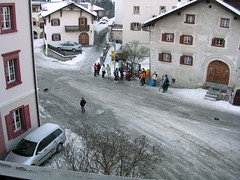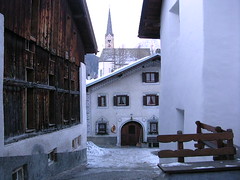Bullwhips Cracking: A Fad I Hope Never Comes to My Town
The bullwhip must have been 12 feet long. Using his entire body for power, he'd swing the whip into action, cracking it on or just above the cobbles. As we drew nearer he stopped and moved aside. When we had passed, he started again. We raised our eyebrows, exchanged bemused glances, and walked to the restaurant.

We finished dinner shortly before 8 and strolled back down to our neighborhood. The air was clear and crisp and, in this narrow valley, the Alps were like huge dark shadows. We first visited this area in 1987 and have been back three or four times, and the beauty of the mountains, the river, which is fast and green with minerally ice-melt, and the village astonishes us each time. Walking back to our apartment that night was no different. Fatigued and well-fed, we were relieved to be there and filled with a sense of well-being.
The area outside our apartment is known locally as Plaz. It’s a small piazza (Plaz, place, plaza, piazza) circled by large, solid Engadiner houses from the seventeenth, eighteenth and nineteenth centuries, with a fountain from which mineral water flows. As we walked through the cold night, we heard the sounds again – cracks and snaps, this time many of them. Five or six boys were in the middle of Plaz, cracking their bullwhips. There was nothing mean or menacing about them. They were simply hanging out with their friends, cracking bullwhips under the street light.

We were in Scuol for eight nights and for eight nights the whippersnappers, as my son dubbed them, were out in force below our apartment. They would arrive after dark and begin whipping. The apartment was on the third floor, and we’d glare down at them from our windows and balcony. On some nights they appeared to be with an older teenager or an adult, who held a sheet of paper, and we thought perhaps this was an organized activity, perhaps practice for a competition. On nights when we went out to dinner, I ignored them. But when we ate at the apartment, I felt like our Alpine idyll was being spoiled by a pastime that I couldn’t help associate with brutal beatings. I played CDs, tuned the radio to local stations that were broadcasting Mozart and Brubeck interspersed by commentary in German, but I couldn’t drown out the sound. Eventually the cracks of the bullwhips faded into the background but I never learned to ignore it.
Every night the whippersnappers remained until almost nine, when the bells at Munt Biselgia, the ancient church that rises above Plaz, rang out the hour and sent them on their way.




2 Comments:
Dear Mr. Andersen,
My name is Pony Horton. As a sport whicracker myself, a read with amusement and delight your article about the bullwhip fad among the youngsters in Switzerland. I have done a small amount of research into the whip hooby, and found that it is popular at ski chalets in the Alps to crack whips for the great echos you get from the rock faces. I've heard that some chalets actually hire these whip artists fpr the amusement of the tourists.
I have to say, as someone used to the quiet of country life, I'd take the popping of a bunch of whips over the bass-driven, deafening thudding that passes for "music" today. At least those kids were keeping a dying art alive.
The Swiss aren't the only ones. When my daughter was in a Western Riding group called Westernaires in Colorado about 25 years ago, she participated in a Whipcracking team. When she and her friends came home from school they did a routine called Rimfire where thy cracked the whips in sequence around the neighborhood. I'm sure they annoyed some neighbors but they had fun. I learned and now her kids are learning.
Post a Comment
<< Home